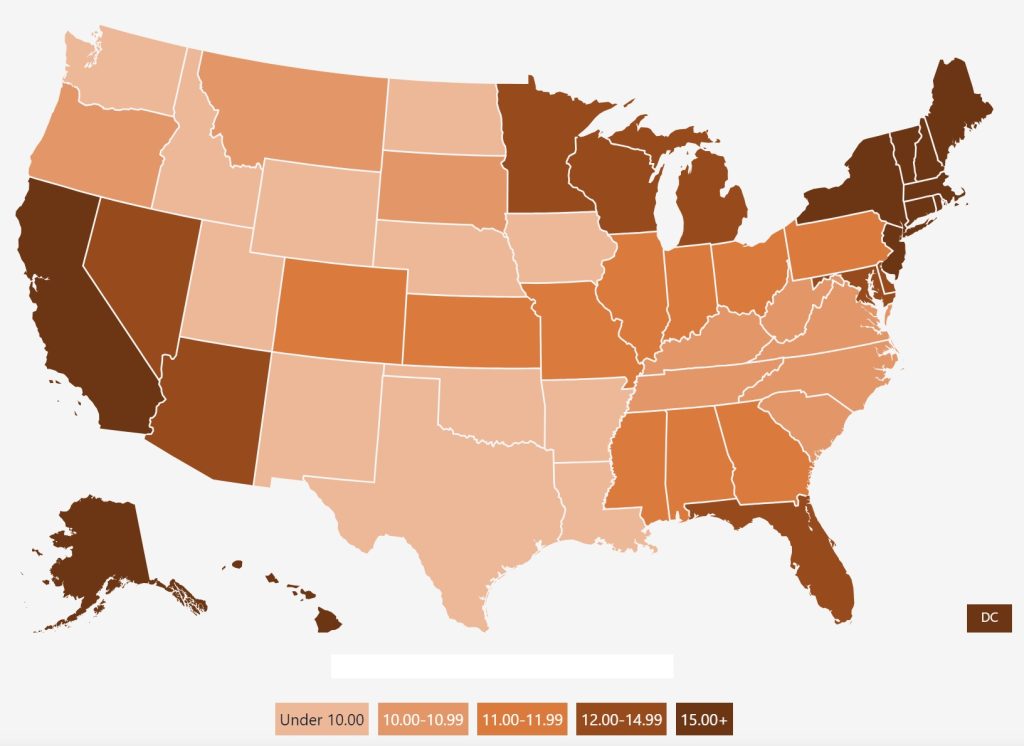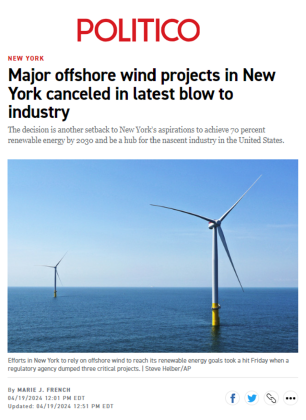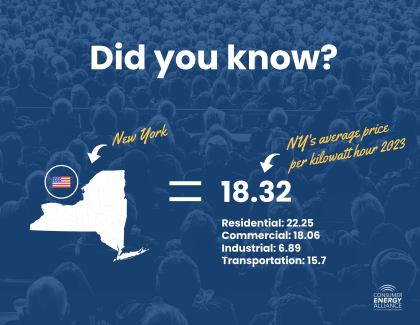To outsiders, New York is an Empire State of Mind, full of big dreams, big stars, and big money. A concrete jungle that looms as large as the personalities of people who wander the streets – known for some of the biggest fashion brands, business headquarters, and the number of billionaires that reside there. But that is not New York. That’s the City.
New York, the state, is much different. With almost 19.5 million people, 44% of its residents are under 18 or above 65. Around 2.8 million people live in poverty—roughly the entire population of Kansas. A little less than half of the state is made up of minority communities. The median income of the State’s 7.6 million households is $81,386. New York is also home to the nation’s third-highest income tax.

On average, New York consumers and businesses pay $0.18 per kWh for electricity, the highest in the country outside New England and the remote states of Alaska and Hawaii. New York state consumers bear the brunt of the cost at roughly $0.23 per kWh or around $300 per month.
Even starker, in its NYC True Co$t of Living report, United Way of New York City noted that in 2021, 36% of households did not have enough income to cover their basic needs, such as housing, food, health care, and transportation. Moreover, half of working-age New Yorkers struggled to cover their basic needs.
Yet, Gov. Kathy Hochul says, “We have a once-in-a-generation opportunity to not just bring relief to families and put more money in people’s pockets today, but also to make historic investments in New Yorkers for years ahead.” But let’s look at what New York’s lofty climate goals, as outlined in the State’s Climate Leadership and Community Protection Act (CLCPA) requiring 70% of New York’s power to be sourced from renewable energy by 2030, will actually do.
Taking into account the above numbers, it is also important to consider the consequences of these “historic investments” in energy – specifically, those made over the last two decades by prior administrations.
Moving to net zero or pushing towards our shared environmental goals via increased use of renewables is not the issue. We all agree that continued environmental progress is critical, and CEA is a strong advocate for adding solar and wind to our overall energy portfolio. It is the pace at which the State’s supermajority is pursuing, as well as its policy choice to restrict or eliminate certain energy options – especially since natural gas, hydropower, and nuclear energy have generated more than 90% of the State’s electricity over the past decade, according to the Energy Information Administration (EIA).
You can’t just look at recent market dynamics to get a clear picture of the increased energy cost. Starting in 2014, then-Gov. Cuomo banned hydraulic fracturing in the state, preventing New York from accessing the same affordable, reliable energy source that Pennsylvania does in the Marcellus Shale. Then, in 2021, the state legislature permanently banned it. The problem with this is that as of 2021, 59% of people in the state used natural gas for heating, and 17% used some fuel oil-derived product. Despite the 76% of households still demanding gas and oil for home heating, while no new pipeline infrastructure has been built despite being approved by the Federal Energy Regulatory Commission. That constricted supply creates higher prices for consumers to get that same fuel.
This occurred when New Yorkers saw the closure of the State’s last coal-fired power plant in 2020 and the 2,000-megawatt Indian Point nuclear plant in 2021. Taken together, that cost the state the ability to power over 2 million homes. With nuclear energy being one of the largest sources of carbon-free power, this is certainly a headscratcher. Worse, though, is that both facilities were shut down without any substitutes for the always-ready power they provided. That’s because, despite the push away from traditional fuels, very few large-scale renewable projects outside of the Champlain Hudson Power Express have moved forward.
 As of late 2023, news headlines have announced that offshore wind and transmission developers have stated that they can’t make the project economics work, even with state and federal subsidies. Businesses, like consumers, face high interest rates, inflation, supply chain issues, and more. Regardless, coastal residents, lake and ocean sides, and conservation groups have vehemently opposed offshore wind, which, outside of large-scale hydro, boasts the best chance to replace some of the lost capacity from the power plant closures just mentioned above.
As of late 2023, news headlines have announced that offshore wind and transmission developers have stated that they can’t make the project economics work, even with state and federal subsidies. Businesses, like consumers, face high interest rates, inflation, supply chain issues, and more. Regardless, coastal residents, lake and ocean sides, and conservation groups have vehemently opposed offshore wind, which, outside of large-scale hydro, boasts the best chance to replace some of the lost capacity from the power plant closures just mentioned above.
Yet, despite the promise of “historic investments,” in October 2023, Gov. Hochul’s administration rejected additional investments for companies to complete more large-scale onshore solar and wind projects. This does not bode well for the State’s carbon-free energy goals and the consumers who lack enough reliable power, pushing energy prices higher.
However, even if the economics worked, 84% of the wires and electrical stations that make up the grid were built before the 1980s. As a result, massive investments will also be needed to modernize the current electric transmission and distribution system.
This is a problem in and of itself, as the Climate Action Council’s final Scoping Plan states that New York will need 15–45 gigawatts (GW) of new “zero emission dispatchable electric generation” by 2040 to meet increased electric demand and maintain electric system reliability, according to the New York Independent System Operator (NY-ISO). That’s 11.2 million to 33.7 million homes, respectively.
Interestingly, permitting and grid interconnection can take 10-20 years once approved. And not much is getting approved.
 Between electric providers, regulators, and consumers – someone has to pay for the new poles and wires, and nobody can agree on who that is, even though electricity is a product in demand. Add in the local, state, and national opposition to new transmission due to conservation, property, and viewshed issues, and even if a transmission project is sited, it doesn’t guarantee its construction.
Between electric providers, regulators, and consumers – someone has to pay for the new poles and wires, and nobody can agree on who that is, even though electricity is a product in demand. Add in the local, state, and national opposition to new transmission due to conservation, property, and viewshed issues, and even if a transmission project is sited, it doesn’t guarantee its construction.
Still, New York legislators and its anti-energy lobbyists continue to introduce policies as if the state was on track to meet its carbon-free electricity goals, implementing a 2035 ban on new gas-powered cars and trucks, creating the All-Electric Building Act, and a ban on natural gas stoves. They have also been pushing legislation to ban leaf blowers and lawnmowers. These will all need to be replaced by electric-powered units, requiring even more electricity from a new generation and more distribution from the new transmission.
Oh, wait.
These are just the top examples; there are more. So, the problem remains: the intentions are good, but the timeline is terrible. Three-quarters of the state still uses traditional fuels for home heating. Consumers have now been holding on to their cars for 12.5 years, on average, seeing as 60 percent of U.S. households can’t afford a new one. Mandating all-electric building codes will lead to higher construction costs and even greater demand for power, further pricing the American dream of home ownership out of reach for millions of New Yorkers.
Add in the inconvenient truth that rental rates in New York are some of the highest in the nation and will be pushed higher by green building mandates. Then, factor in New York’s accelerated carbon-free energy push by taking away consumer choice. And then, all New Yorkers are left with is less reliable and more unaffordable electricity – all because New York politicians have chosen political expediency instead of practical reality, and they are the ones deciding for New Yorkers.
It’s supposed to be the other way around.

